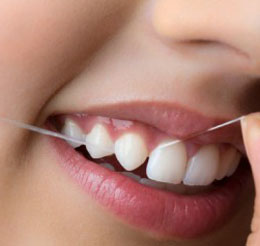 This simple and straightforward technique will prevent plaque from accumulating in-between teeth. It is inexpensive and you don’t need the assistance of a dental professional after you learn to perform it the correct way.
Flossing does more that clear pieces of food that are caught in your teeth. Only floss can reach surfaces between teeth that the bristles of your toothbrush can’t penetrate and dislodge plaque.
If you have healthy gums, you should floss when you brush after breakfast and at bedtime. Those with periodontal disease should brush and floss after lunch as well.
This simple and straightforward technique will prevent plaque from accumulating in-between teeth. It is inexpensive and you don’t need the assistance of a dental professional after you learn to perform it the correct way.
Flossing does more that clear pieces of food that are caught in your teeth. Only floss can reach surfaces between teeth that the bristles of your toothbrush can’t penetrate and dislodge plaque.
If you have healthy gums, you should floss when you brush after breakfast and at bedtime. Those with periodontal disease should brush and floss after lunch as well.
Here is the correct procedure.
- Take about 12 inches of dental floss. Wrap the ends a couple of times around your index fingers or till it feels secure enough.
- Press thumbs against your index fingers to hold the floss loops in place. Extend your middle fingers to press against the rest of the floss so there is a shorter length of taut gloss between them. Start inserting in between the far end of your upper jaw and work toward the center.
- Open your mouth only slightly, so your cheeks are not tight against the teeth. Insert the taut length of floss behind the rearmost upper molar, until it touches the gum. In the process, your gum should not bleed or hurt. If it does, you are pressing too hard. Pull the ends of the floss forward, until parts of the inner and outer surfaces of the tooth are covered. To dislodge plaque, rub the floss two or three times up and down the tooth surface; not back and forth.
- Insert floss between your last molar and the very next tooth. Pull the floss gently back and forth until it passes between the two teeth. Press the floss against one tooth and rub it up and down several times. Then press the floss against the other tooth and repeat the process.
- Move to the next space and continue until you reach your central incisors. Then go to the rear molar on the other side and floss from there towards the center.
- In case the floss starts fraying or if deposits build heavily on it, you can release a loop from one index finger and take up the slack on the other.
- The teeth of the lower jaw should be flossed the same way; starting from the rearmost molar at each end and working toward the center.
- Rinse thoroughly to flush away the loosened plaque.
If you have tightly spaced teeth where you cannot readily force the floss, you can use a floss threader, a device that enables you to insert one end of the floss directly through the spaces between teeth. The floss threader can also be used under fixed bridges where the spaces between teeth are connected. If you have difficulty holding the ends of the floss, you can use floss holders available in shops. If you have more questions and if you require a flossing demonstration, please talk to us at Dr32.

